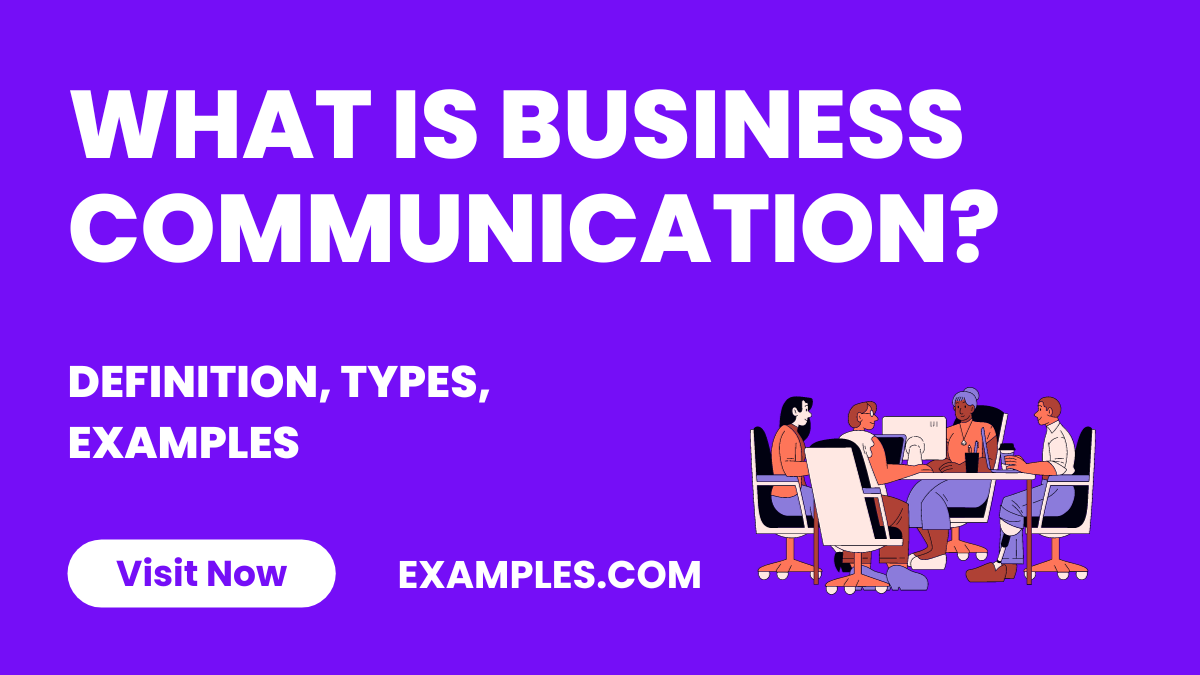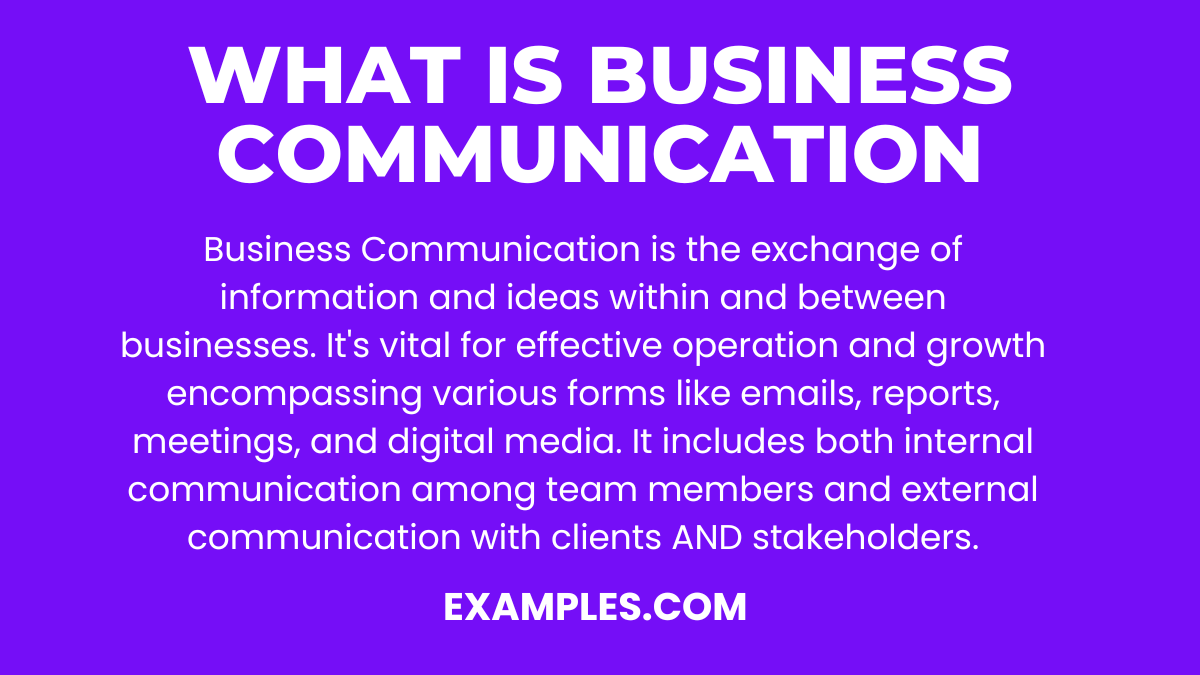What is Business Communication? – Definition, Types, Examples
Business communication is an integral part of modern corporate functioning, encompassing the exchange of ideas, information, and opinions within and outside an organization. This comprehensive guide delves into the nuances of effective communication strategies, showcasing various Communication Examples to illustrate key points. From internal memos to external marketing campaigns, understanding the dynamics of business communication is crucial for fostering a productive and harmonious workplace. This article offers insights into different types, styles, and effective techniques, providing a valuable resource for professionals aiming to enhance their communicative skills in the business realm.
Download Why Do You Need Business Communication PDF
What is Business Communication?
Business Communication refers to the process of sharing information within and outside a company. It involves exchanging ideas, messages, and data to achieve organizational goals. This communication can take many forms, such as face-to-face meetings, emails, reports, and phone calls. It’s essential for coordinating activities, making decisions, and building professional relationships. Effective business communication ensures everyone in the organization is on the same page, helping to foster a productive and efficient work environment. In simple terms, it’s the way companies talk to each other and to the world.
Examples of Business Communication
Understanding Business Communication is crucial for any organization’s success. It’s about conveying messages effectively to achieve corporate goals. This involves various methods, tailored to different contexts and audiences. Here, we explore 10 distinct examples that highlight its importance and diversity:
- Emails: A primary tool for internal and external communication, conveying information succinctly.
- Meetings: Facilitate direct dialogue, idea exchange, and decision-making among team members.
- Presentations: Used to pitch ideas, report on progress, or provide training.
- Reports: Written documents for detailed information sharing, analysis, and record-keeping.
- Newsletters: Regular updates to employees or customers about company news and events.
- Social Media Posts: Engage with a broader audience, enhancing brand visibility and customer interaction.
- Video Conferences: Connect teams across different locations, essential for remote communication.
- Phone Calls: For quick, direct communication, often used for immediate decision-making.
- Corporate Websites: Serve as a public face of the company, providing information and updates.
- Feedback Forms: Collect opinions and feedback, vital for continuous improvement and customer satisfaction.
Types of Business Communication
Types of Business communication is diverse, encompassing various forms and methods to convey information effectively within and outside an organization. Understanding these types is crucial for effective communication strategy implementation.
- Business Communication Quotes: Business Communication quotes in business communication offer wisdom and insight, encapsulating powerful ideas in a few words. They motivate and guide professionals, providing clarity and perspective on effective communication strategies within the corporate world.
- Business Communication Books: Business Communication books are comprehensive resources that delve into theories, strategies, and practical tips for effective business communication. They cover various aspects, from interpersonal skills to digital communication, serving as essential guides for professionals and students alike.
- Business Communication for Students: Business Communication for Students focuses on equipping students with the necessary communication skills for the business environment. It includes learning effective speaking, writing, listening, and teamwork skills, preparing them for future professional interactions and challenges.
- Business Communication in the Workplace: Business Communication in the Workplace refers to the everyday communication activities within a business setting. It involves internal and external communication, ensuring clear, efficient, and purposeful exchange of information among employees, management, and other stakeholders.
- Intercultural Business Communication: Intercultural Business Communication deals with communication across different cultures and nationalities in the business context. This type emphasizes understanding and adapting to cultural differences, which is crucial in global business operations for fostering respect, cooperation, and successful international relationships.
Elements of Business Communication
- Importance of Business Communication: Importance of Business Communication Business communication is key to organizational success, fostering clear understanding, decision-making, and relationship building. It enhances team collaboration, drives efficiency, and improves stakeholder engagement, crucial for achieving business goals.
- Process of Business Communication: Process of Business Communication Involves stages like planning, encoding, transmitting, receiving, and decoding messages. Effective processes ensure clarity and purpose, facilitating accurate and timely information exchange within and outside the organization.
- Business Communication Skills: Business Communication Skills Essential skills include clear articulation, active listening, empathy, and feedback. These skills enable effective interaction and understanding among team members, clients, and stakeholders, enhancing collaboration and problem-solving.
- Business Communication Techniques: Business Communication Techniques like storytelling, visual communication, assertive language, and non-verbal cues improve message delivery. They enhance engagement, understanding, and retention of information, essential for successful communication in business.
- Written Communication in Business: Involves crafting emails, reports, proposals, and memos. Clarity, conciseness, and tone are vital in written communication to convey messages effectively and maintain professionalism.
- Effective Business Communication: Effective Business Communication Focuses on clear, concise, and purposeful exchange of information. It involves understanding the audience, choosing the right medium, and providing timely feedback, essential for successful operations and relationships.
- Business Communication Tools: Business Communication Tools like email, instant messaging, video conferencing, and collaboration platforms facilitate communication. They enable efficient and effective information exchange, catering to diverse communication needs in a business.
- Advantages of Business Communication: Advantages of Business Communication Enhances organizational efficiency, improves team coordination, and boosts employee morale. Good communication also aids in conflict resolution, fosters innovation, and strengthens customer relations, contributing to overall business success.
Business Communication Skills Loud and Clear likely emphasizes the importance of effective communication in the business world. The focus would be on developing skills to communicate messages clearly and confidently, ensuring they are heard and understood. Such a resource would cover aspects like articulating thoughts effectively, active listening, and the ability to tailor messages for different audiences and contexts. It may also delve into non-verbal communication, including body language and tone, which play a crucial role in how messages are received. Emphasizing clarity and assertiveness, this topic is essential for successful interactions in any professional setting.
Communicating effectively on the Business Queensland website offers detailed guidance on enhancing business communication skills. It emphasizes the importance of effective communication in managing relationships with staff, customers, and stakeholders, and how poor communication can damage these relationships. The page covers various aspects, such as key communication and personal awareness skills, verbal communication techniques, using questions effectively, and the importance of active listening. It also delves into non-verbal communication, meeting new people, phone communications, and the increasing use of video calls in business. Additionally, it provides tips for better written communication in business settings.



